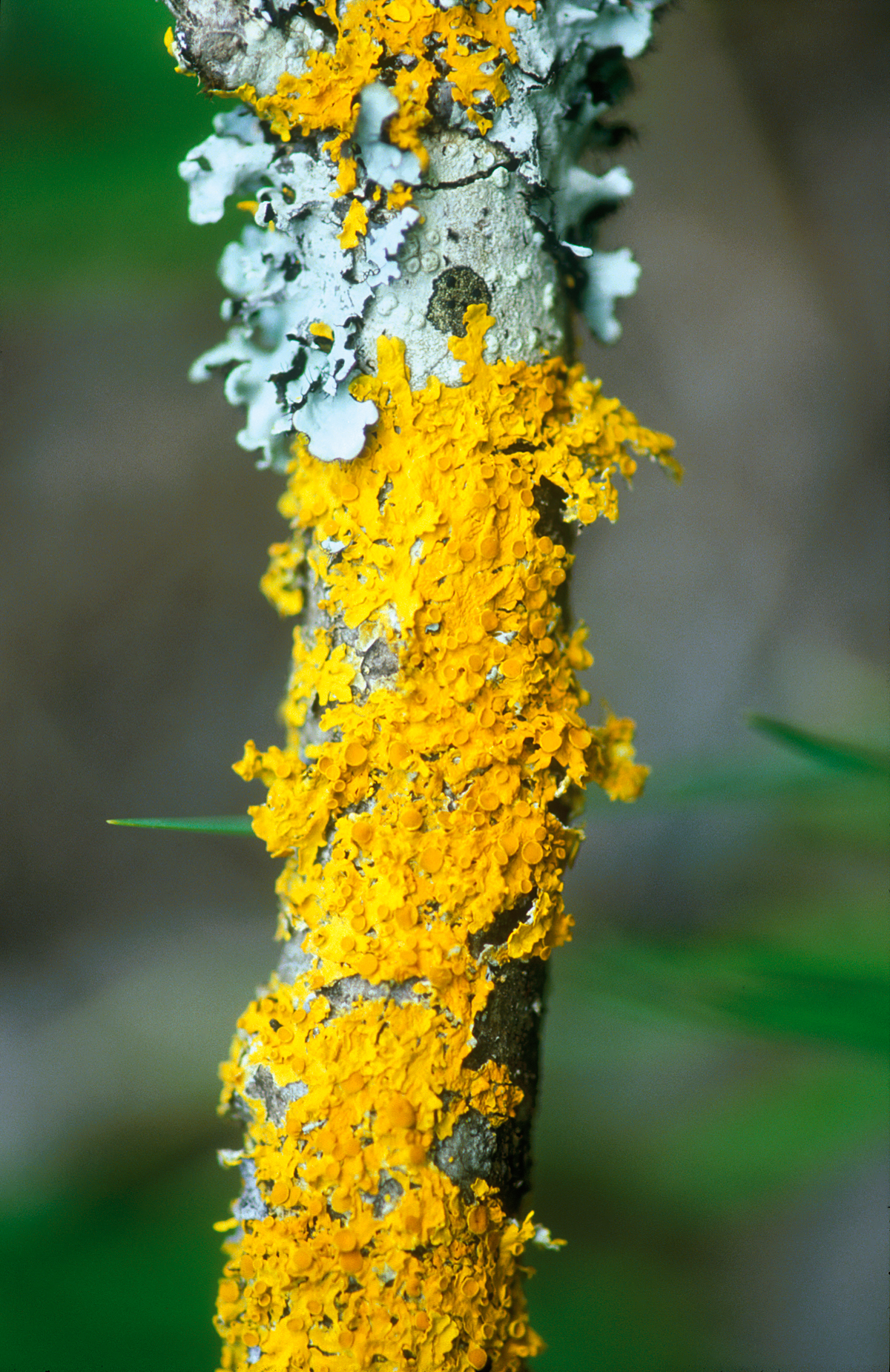|
Thallophyte
Thallophytes (Thallophyta or Thallobionta) are a polyphyletic group of non-motile organisms traditionally described as "thalloid plants", "relatively simple plants" or " lower plants". They form a division of kingdom Plantae that include lichens and algae and occasionally bryophytes, bacteria and slime moulds. Thallophytes have a hidden reproductive system and hence they are also incorporated into the similar Cryptogamae category (together with ferns), as opposed to Phanerogamae. Thallophytes are defined by having undifferentiated bodies ( thalloid, pseudotissue), as opposed to cormophytes (Cormophyta) with roots and stems. Various groups of thallophytes are major contributors to marine ecosystems. Definitions Several different definitions of the group have been used. Thallophytes (Thallophyta or Thallobionta) are a polyphyletic group of non-mobile organisms traditionally described as "thalloid plants", "relatively simple plants" or " lower plants". Stephan Endlicher, a 19 ... [...More Info...] [...Related Items...] OR: [Wikipedia] [Google] [Baidu] |
Thallus
Thallus (: thalli), from Latinized Greek (), meaning "a green shoot" or "twig", is the vegetative tissue of some organisms in diverse groups such as algae, fungi, some liverworts, lichens, and the Myxogastria. A thallus usually names the entire body of a multicellular non-moving organism in which there is no organization of the tissues into organs. Many of these organisms were previously known as the thallophytes, a polyphyletic group of distantly related organisms. An organism or structure resembling a thallus is called thalloid, thalloidal, thalliform, thalline, or thallose. Even though thalli do not have organized and distinct parts ( leaves, roots, and stems) as do the vascular plants, they may have analogous structures that resemble their vascular "equivalents". The analogous structures have similar function or macroscopic structure, but different microscopic structure; for example, no thallus has vascular tissue. In exceptional cases such as the Lemnoideae, where th ... [...More Info...] [...Related Items...] OR: [Wikipedia] [Google] [Baidu] |
Cormophyte
Cormophytes (Cormophyta) is a historical term seldom used today for the plants that are differentiated into roots, Plant stem, stems and leaf, leaves. These plants differ from thallophytes, whose body is referred to as the thallus, i.e. a simple body not differentiated into leaves and stems. Definitions have varied, notably about whether mosses and liverworts are included. Stephan Endlicher, a 19th-century Austrian botanist, divided the vegetable kingdom in 1836 into two groups: the thallophytes were only the algae, lichens and fungi, and the cormophytes were the mosses, liverworts, ferns, Equisitaceae, club mosses and seed plants. References Plants Biological classification Historically recognized plant taxa {{Botany-stub ... [...More Info...] [...Related Items...] OR: [Wikipedia] [Google] [Baidu] |
Cryptogams
A cryptogam (scientific name ''Cryptogamae'') is a plant, in the broad sense of the word, or a plant-like organism that share similar characteristics, such as being Multicellular organism, multicellular, Photosynthesis, photosynthetic, and primarily immobile, that reproduces via spores rather than through Flower, flowers or seeds. This broader definition can include algae, fungi, and certain bacteria (like cyanobacteria), even though they may belong to different Biological kingdom, biological kingdoms. Taxonomy The name ''Cryptogamae'' () means "hidden reproduction", meaning non-seed bearing plants. Other names, such as "thallophytes", "lower plants", and "spore plants" have occasionally been used. As a group, Cryptogamae are paired with the Phanerogamae or Spermatophyta, the seed plants. At one time, the cryptogams were formally recognised as a group within the plant kingdom. In his system for classification of all known plants and animals, Carl Linnaeus (1707–1778) ... [...More Info...] [...Related Items...] OR: [Wikipedia] [Google] [Baidu] |
Cryptogam
A cryptogam (scientific name ''Cryptogamae'') is a plant, in the broad sense of the word, or a plant-like organism that share similar characteristics, such as being multicellular, photosynthetic, and primarily immobile, that reproduces via spores rather than through flowers or seeds. This broader definition can include algae, fungi, and certain bacteria (like cyanobacteria), even though they may belong to different biological kingdoms. Taxonomy The name ''Cryptogamae'' () means "hidden reproduction", meaning non-seed bearing plants. Other names, such as "thallophytes", "lower plants", and "spore plants" have occasionally been used. As a group, Cryptogamae are paired with the Phanerogamae or Spermatophyta, the seed plants. At one time, the cryptogams were formally recognised as a group within the plant kingdom. In his system for classification of all known plants and animals, Carl Linnaeus (1707–1778) divided the plant kingdom into 24 classes, one of which was the ... [...More Info...] [...Related Items...] OR: [Wikipedia] [Google] [Baidu] |
Pteridophyte
A pteridophyte is a vascular plant (with xylem and phloem) that reproduces by means of spores. Because pteridophytes produce neither flowers nor seeds, they are sometimes referred to as " cryptogams", meaning that their means of reproduction is hidden. They are also the ancestors of the plants we see today. Ferns, horsetails (often treated as ferns), and lycophytes ( clubmosses, spikemosses, and quillworts) are all pteridophytes. However, they do not form a monophyletic group because ferns (and horsetails) are more closely related to seed plants than to lycophytes. "Pteridophyta" is thus no longer a widely accepted taxon, but the term ''pteridophyte'' remains in common parlance, as do ''pteridology'' and ''pteridologist'' as a science and its practitioner, for example by the International Association of Pteridologists and the Pteridophyte Phylogeny Group. Etymology The name ''Pteridophyte'' is a Neo-Latin compound word created by English speakers around 1880. It is for ... [...More Info...] [...Related Items...] OR: [Wikipedia] [Google] [Baidu] |
Bryophyte
Bryophytes () are a group of embryophyte, land plants (embryophytes), sometimes treated as a taxonomic Division (taxonomy), division referred to as Bryophyta ''Sensu#Common qualifiers, sensu lato'', that contains three groups of non-vascular plant, non-vascular land plants: the Marchantiophyta, liverworts, hornworts, and mosses. In the Sensu#Common qualifiers, strict sense, the division Bryophyta consists of the mosses only. Bryophytes are characteristically limited in size and prefer moist habitats although some species can survive in drier environments. The bryophytes consist of about 20,000 plant species. Bryophytes produce enclosed reproductive structures (gametangia and sporangia), but they do not produce flowers or seeds. They reproduce sexually by spores and asexually by fragmentation or the production of Gemma (botany), gemmae. Though bryophytes were considered a paraphyletic group in recent years, almost all of the most recent phylogenetics, phylogenetic evidence support ... [...More Info...] [...Related Items...] OR: [Wikipedia] [Google] [Baidu] |
Adolf Engler
Heinrich Gustav Adolf Engler (25 March 1844 – 10 October 1930) was a German botanist. He is notable for his work on plant taxonomy and phytogeography, such as ''Die natürlichen Pflanzenfamilien'' (''The Natural Plant Families''), edited with Karl Anton Eugen Prantl, Karl A. E. von Prantl. Even now, his system of plant classification, the Engler system, is still used by many Herbarium, herbaria and is followed by writers of many manuals and Flora (plants), floras. It is still the only system that treats all 'plants' (in the wider sense, algae to flowering plants) in such depth. Engler published a prodigious number of taxonomic works. He used various artists to illustrate his books, notably Joseph Pohl (1864–1939), an illustrator who had served an apprenticeship as a wood-engraver. Pohl's skill drew Engler's attention, starting a collaboration of some 40 years. Pohl produced more than 33 000 drawings in 6 000 plates for ''Die naturlichen Pflanzenfamilien''. He also illustrate ... [...More Info...] [...Related Items...] OR: [Wikipedia] [Google] [Baidu] |
Fungus
A fungus (: fungi , , , or ; or funguses) is any member of the group of eukaryotic organisms that includes microorganisms such as yeasts and mold (fungus), molds, as well as the more familiar mushrooms. These organisms are classified as one of the kingdom (biology)#Six kingdoms (1998), traditional eukaryotic kingdoms, along with Animalia, Plantae, and either Protista or Protozoa and Chromista. A characteristic that places fungi in a different kingdom from plants, bacteria, and some protists is chitin in their cell walls. Fungi, like animals, are heterotrophs; they acquire their food by absorbing dissolved molecules, typically by secreting digestive enzymes into their environment. Fungi do not photosynthesize. Growth is their means of motility, mobility, except for spores (a few of which are flagellated), which may travel through the air or water. Fungi are the principal decomposers in ecological systems. These and other differences place fungi in a single group of related o ... [...More Info...] [...Related Items...] OR: [Wikipedia] [Google] [Baidu] |
Lycopodiophytes
The lycophytes, when broadly circumscribed, are a group of vascular plants that include the clubmosses. They are sometimes placed in a division Lycopodiophyta or Lycophyta or in a subdivision Lycopodiophytina. They are one of the oldest lineages of extant (living) vascular plants; the group contains extinct plants that have been dated from the Silurian (ca. 425 million years ago). Lycophytes were some of the dominating plant species of the Carboniferous period, and included the tree-like Lepidodendrales, some of which grew over in height, although extant lycophytes are relatively small plants. The scientific names and the informal English names used for this group of plants are ambiguous. For example, "Lycopodiophyta" and the shorter "Lycophyta" as well as the informal "lycophyte" may be used to include the extinct zosterophylls or to exclude them. Description Lycophytes reproduce by spores and have alternation of generations in which (like other vascular plants) the sporophyte ... [...More Info...] [...Related Items...] OR: [Wikipedia] [Google] [Baidu] |
Equisetopsida
Equisetidae is one of the four subclasses of Polypodiopsida (ferns), a group of vascular plants with a fossil record going back to the Devonian. They are commonly known as horsetails. They typically grow in wet areas, with whorls of needle-like branches radiating at regular intervals from a single vertical stem. The Equisetidae were formerly regarded as a separate division of spore plants and called Equisetophyta, Arthrophyta, Calamophyta or Sphenophyta. When treated as a class, the names Equisetopsida s.s. and Sphenopsida have also been used. They are now recognized as rather close relatives of the ferns (Polypodiopsida) of which they form a specialized lineage. However, the division between the horsetails and the other ferns is so ancient that many botanists, especially paleobotanists, still regard this group as fundamentally separate at the higher level. Description The horsetails comprise photosynthesising, "segmented", hollow stems, sometimes filled with pith. At the ju ... [...More Info...] [...Related Items...] OR: [Wikipedia] [Google] [Baidu] |
Lindley System
An early system of plant taxonomy, the Lindley system, was first published by John Lindley as ''An Introduction to the Natural System of Botany'' (''Natural History'', 1830). This was a minor modification of that of de Candolle (1813). He developed this further over a number of publications, including the ''Nixus plantarum'' (1833) and a second edition of ''Natural History'' (1836), in which he introduced the concept of a higher order of taxonomic rank, the Alliances, in which he embedded the Tribes (families). He also expanded his ideas on Exogens in his entry of that name in the Penny Cyclopedia (1838). In 1839 he revised his division of the plant kingdom into classes in an article in the Botanical Register. Lindley's system culminated in the three editions of his ''Vegetable Kingdom'' (1846, 1847, 1853). The schema of the ''Natural History'' is shown on pages xxxv and xxxvii-xlviii. In the ''Vegetable Kingdom'', the schema for the first edition is on pp. lv–lxviii. The ... [...More Info...] [...Related Items...] OR: [Wikipedia] [Google] [Baidu] |
Biodiversity Heritage Library
The Biodiversity Heritage Library (BHL) is the world’s largest open-access digital library for biodiversity literature and archives. BHL operates as a worldwide consortium of natural history, botanical, research, and national libraries working together to address this challenge by digitizing the natural history literature held in their collections and making it freely available for open access as part of a global "biodiversity community". The BHL consortium works with the international taxonomic community, publishers, bioinformaticians, and information technology professionals to develop tools and services to facilitate greater access, interoperability, and reuse of content and data. BHL provides a range of services, data exports, and APIs to allow users to download content, harvest source data files, and reuse materials for research purposes. Through taxonomic intelligence tools developed by Global Names Architecture, BHL indexes the taxonomic names throughout the collection, al ... [...More Info...] [...Related Items...] OR: [Wikipedia] [Google] [Baidu] |









